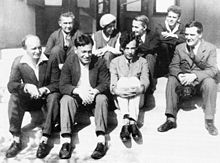|
UPTI Affair
 UPTI Affair (Ukrainian: Справа УФТІ, Sprava UFTI; Russian: Дело УФТИ, Delo UFTI) was a series of repressions against a number of scholars of the Ukrainian Physics and Technology Institute in Kharkov, Soviet Ukraine, by the Main Directorate of State Security (GUGB) during 1938, a part of the Great Purge.[1] As a result, the UFTI leaders, including a Soviet experimental physicist Lev Shubnikov, were arrested and executed during this crisis. In the response to the state of affairs, the Soviet physicists Moisey Korets and Lev Landau, wrote the Korets–Landau leaflet which directly condemned Joseph Stalin and the secret police NKVD. Korets and Landau, as well as another implicated scientist, Yuri Rumer, were arrested. Landau was released, but Korets and Rumer were imprisoned in sharashkas of gulag. Detentions
In total, 16 UPTI employees suffered from repression. The first to be arrested was Korets, on November 28, 1935, but was soon released and reinstated at UPTI. On May 26, 1936, Eva Zeisel (artistic director of the porcelain and glass industry of the USSR, at that time the ex-wife of Alexander Weissberg) was arrested in Moscow, she was accused of preparing an assassination attempt on Stalin, at first she was sent to the internal prison at Lubyanka, then to Kresty Prison. Alexander Weisberg traveled to Leningrad, then to Moscow, to intercede for Eva. Walking around offices in Moscow took several months and in September 1937, Eva was unexpectedly released, given a new passport and deported from the country. Through Poland she came to Austria. In February 1937, Korets, following Lev Landau, moved to Moscow. In 1937 (after Landau left for Moscow), five leading employees of the UPTI were arrested and shot : Lev Shubnikov, L. V. Rozenkevich, V. S. Gorsky, V. P. Fomin and K.B. Weiselberg; two foreign nationals were arrested and subsequently handed over to the Gestapo: Fritz Houtermans (member of the German Communist Party) and Weissberg (member of the Communist Party of Austria). Fritz Lange is the only foreign scientist who was neither arrested nor deported. Lange was among the first group of German anti-fascists to come to the USSR, and his new Soviet documents were signed personally by Stalin. These documents probably saved F. Lange from reprisals. Pyotr Frolovich Komarov, who replaced Weisberg in this position, and the head of the supply department, Konstantin Aleksandrovich Nikolaevsky, were shot. In 1937, graduate students Ivan Maksimovich Gusak and Pyotr Nikolaevich Komarov were also arrested. Gusak was released and continued to work at UPTI, but died in the Eastern Front. Komarov died in custody. The same year, as part of the UPTI Case, Isaak Pomeranchuk was expelled from the Komsomol “for connections with Landau”. In February 1938, Georgy Demidov was arrested, tried by the Military Tribunal and sentenced to 5 years in Kolyma. In 1951, he was taken from Kolyma to work on an atomic project as an experimental physicist. Thanks to the tests, his term of imprisonment was expiring in a few months, he was sent to the north of the Komi Republic, to Inta, as an administrative exile. Then he moved to Ukhta, where from 1954 he worked at the Ukhta Mechanical Plant. On April 26, 1938, on Arbat in Moscow, Moscow State University professor Yuri Rumer was arrested “as an accomplice of the enemy of the people Landau” when he was on his way with friends to celebrate his birthday. In 1953, after the end of his period of exile, he was hired as a senior researcher at the West Siberian Branch of the Academy of Sciences of the Soviet Union. Rumer, Landau and Korets were arrested . Korets was arrested on April 27, 1938, amnestied on March 18, 1952, after serving 14 years in the correctional labour camp, and until 1958 he was in exile, working at the Intaugol ("Inta-Coal") plant. Landau was arrested on April 28, 1938. The accusations against him related to his work at UPTI. The future Nobel laureate in Physics spent exactly a year in prison. Landau was released on April 28, 1939 thanks to the petition of Niels Bohr and Pyotr Kapitsa. On June 4, 1938, the second director of the UPTI, Aleksandr Leipunskii, was arrested, but was released on August 7 of the same year. On June 22, 1938, the first director of the UPTI, Ivan Obreimov, was arrested . On November 19, 1940, he was sentenced to 8 years in forced labor camps and sent to the city of Kotlas. Sergey Vavilov, Abram Ioffe, Vladimir Leontyevich Komarov and others spoke in his defense. On May 21, 1941, he was released due to the lack of evidence of a crime and reinstated at his job at UPTI. Martin Ruhemann was able to emigrate: he applied for exit visas for him and his wife, Barbara Ruhemann, and they were able to move to England in Spring 1938.[2]: 26 He obtained a position at the Imperial College.[3] UPTI ceased to exist as a center of theoretical and experimental physics on a European scale, and Houtermans ended up in Nazi Germany, involved there in the German nuclear program. In 1951, Houtermans published a book Russian Purge and the Extraction of Confession, written by him with his cellmate in the Kyiv Lukyanivska Prison, Konstantin Shteppa (published under pseudonyms). References
External links |